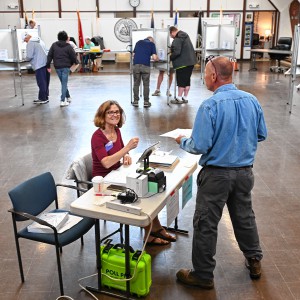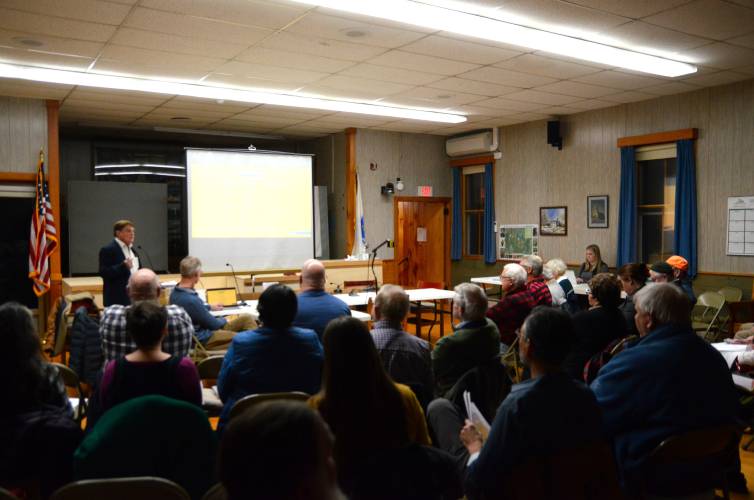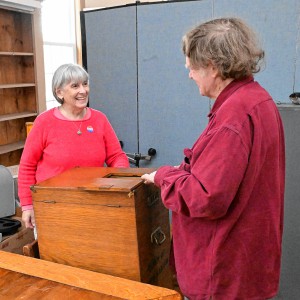Six-town board shares costs of potential school district merger
| Published: 11-15-2023 4:21 PM |
GILL — More than 40 officials, school representatives and other stakeholders from six towns convened Tuesday to consider what regionalization of the Gill-Montague and Pioneer Valley regional school districts might entail, particularly in terms of cost.
The meeting of the Six Town Regionalization Planning Board involved a presentation of assessments conducted by the Abrahams Group and a question and answer session at Town Hall. The assessments, which board Chairman Alan Genovese stressed are largely estimates of potential costs, outlined budget adjustments that would correspond with consolidating the two districts.
Neither the board nor any of the involved towns made any decision relative to regionalization at Tuesday’s meeting, with town officials opting to discuss the prospect individually with their respective municipalities as a next step.
Assessments were conducted using “a number of different methodologies” that help demonstrate the feasibility of regionalization, according to Genovese. One highlight is a salary schedule modeled after the Gill-Montague Regional School District’s version that adds two wage grade steps; allows all teachers at Gill-Montague and Pioneer to be placed at the same salary step as they are now and not make less than they are making currently; and translates to a projected additional cost of $201,981, according to the Abrahams Group.
Another key portion of the presentation outlined the cost savings associated with consolidating central office staff. Collectively, salaries for combined central office staff would amount to about $2.09 million, translating to a projected savings of $316,772 when considering the nearly $2.41 million total that is currently being spent across both districts.
The full presentation, which includes figures related to how much each town would be assessed, can be found at sites.google.com/view/strpb/reportssurveys.
Six Town Regionalization Planning Board member David Young, who also serves as Warwick’s town coordinator, said after the presentation that he approves of the board primarily focusing on optimizing educational offerings rather than maximizing cost savings. He added that some balance should be sought, however.
“I personally arrived here wanting to find ways to save money and become as sustainable as possible, but very clearly, we want to not go through what I witnessed at Pioneer with a lot of cutting. It was damaging to what we were able to offer,” said Young, who was also formerly a Pioneer School Committee member. Warwick separated from the Pioneer Valley Regional School District and reopened Warwick Community School independently this school year. “I think it’s significant that we have a model that says that we do achieve some cost savings, even though the model rounded up to a higher common denominator just about everywhere.”
Article continues after...
Yesterday's Most Read Articles
 Serious barn fire averted due to quick response in Shelburne
Serious barn fire averted due to quick response in Shelburne
 Bridge of Flowers in Shelburne Falls to open on plant sale day, May 11
Bridge of Flowers in Shelburne Falls to open on plant sale day, May 11
 Political newcomer defeats Shores Ness for Deerfield Selectboard seat
Political newcomer defeats Shores Ness for Deerfield Selectboard seat
 Roundup: Pioneer baseball wins Suburban League West title following 2-0 win over Hopkins
Roundup: Pioneer baseball wins Suburban League West title following 2-0 win over Hopkins
 As I See It: Between Israel and Palestine: Which side should we be on, and why?
As I See It: Between Israel and Palestine: Which side should we be on, and why?
 Employee pay, real estate top Erving Town Meeting warrant
Employee pay, real estate top Erving Town Meeting warrant
“The dynamics have just changed so much, the landscape with the Student Opportunity Act,” Genovese added, indicating a shift away from a cost benefit focus. “It sort of morphed into, ‘Wow, there are a lot of opportunities for kids.’”
Genovese summarized that most involved officials, school staff and families want more information before taking a firm stance relative to whether regionalization would be advantageous. Most people at Tuesday’s meeting expressed a desire to continue exploring the financial feasibility of a merger, but not everyone was optimistic that regionalization would be realistic.
“Idealistically, I want to see something in this for everyone. I want to see a better pay scale for teachers, better health care plans, better education for students and less money for the towns,” Leyden Finance Committee Chair Ginger Robinson said, eliciting laughter from those in attendance due to the frankness of her final goal to bolster education funding. “But I honestly think if we don’t get all of those, I don’t know if this is going to go anywhere and I don’t think we’re going to get to that part for the towns unless we close schools. I hate saying that … but the reality of it is that schools need students.”
Towns are expected to individually discuss how favorable regionalization would be over the next few weeks. Genovese said the Six Town Regionalization Planning Board will then convene another meeting to gather input and move toward a recommendation that a vote to regionalize be placed on Town Meeting warrants in involved municipalities, contingent on a mutually agreeable plan being supported by each town’s officials. Should each town vote to regionalize, a transition plan would be developed and implemented over the course of two years.
Reach Julian Mendoza at 413-930-4231 or jmendoza@recorder.com.



 New Salem election ushers in new Selectboard member
New Salem election ushers in new Selectboard member Community Legal Aid expands Disability Benefits Project to Franklin County
Community Legal Aid expands Disability Benefits Project to Franklin County
